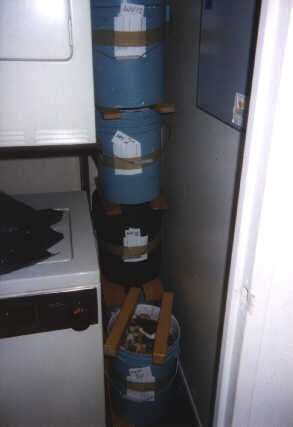709-218-7927 The Landfall Garden House 60 Canon Bayley Road Bonavista, Newfoundland CANADA A0C 1B0 |
|---|
Vermicomposting in the Cold-Climate Apartment - Maintenance
Diet
I collect all my paper and cardboard and tear it into 2-cm chunks while I'm watching TV. I hate to waste anything, even brain cells (grin!). I place a bed of about three inches of cardboard chips in the tub, cover it with soil, then start adding layers of vegetable waste and soil with the red worms.
I have found that paper screwed into a ball does not digest as well as paper torn into shreds. I suspect that the balled paper contains too much air for worms to navigate (and hence chew), and that the balled paper has a tendency to clog a narrow structure such as a sewer-pipe.
What, if anything, is harmful about composting meat products in a worm composter bin? I'm thinking of the infamous red- wrigglers as the worms-that-eat-anything-and-eat-it-quickly. We don't put any meat or fats into outdoor bins as it attracts vermin. E. Coli (Sp.?) and similar bacteria or viruses may cause problems if the compost is used for fruit and vegetables, which are then not properly washed or cooked.
Rotation
When the first tub is full, I start on the second, then the third. Ad, but not, nauseum.
By having four or five tubs going, I'm cascading soil and worms from one to the other. The greedy monsters have plenty of time to work over a tub before they get troweled into a fresh tub.
I can yank the oldest tub of soil (for use as potting medium) out of the cycle at any time.
Fluid
Surplus fluid is held to be fatal to the Vermicomposting operation. In the kitchen sink I keep a one litre plastic ice-cream tub with a few holes gouged in the base. In the tub sits a circular piece of fly-mesh. Into the tub go the daily refuse pieces, including coffee-grounds and tea-leaves. The lid stays on. Excess fluids drain from this tub overnight, and first thing in the morning I put the drained matter in the composter. Not so much excess fluid for me, ho ho!
The material destined for the large tubs is pretty well drained by the time it's done. I pre-drain scraps in the kitchen sink container, place drained scraps in the large tubs for digestion. By the time I transfer the digested material to the smaller ice-cream tubs, there is little excess moisture.
I sit the tubs on any kind of impervious plastic sheet or tray to collect surplus fluid. There is none.
If your composter does get overloaded with fluid, you'll probably notice a river-bottom odor coming from the bin. Don't despair. Remove the soil, perhaps in small amounts in plastic supermarket bags, clean out the bin or pails, and reintroduce the soil and worms mixture gradually by the trowel-load. This will give the soil some aeration and drainage properties it had lost. If you have a chance to add some strong fibrous material, such as straw, so much the better.
Worms
I've been sifting and shoving bins around on the balcony and we're dropping to about 2°C here, 35°F. I've noticed that worms are distinctly sluggish when I bring some soil indoors and tip it into another bin, however the babies, thin white worms about 5 mm long, seem to head back into the soil faster than the mature adults (big fat red juicy ...)
Maybe the worm mass is more robust than we imagine, and maybe the eggs or babies are built to tolerate extremes more so than the adults. Your visible adults might have died, but minute offspring may have survived.
However you plan it, you will have to bring the bin/bins inside. The question is where and how.
Last year I used a spare bin on the balcony to hold naught but the food waste. It froze something wonderful! Came spring I begged some worms off a friend and then introduced the little blighters to a veritable orgy of waste. Even then, over winter, I'd produced not more than two tubs of waste. I'm not a big waster.
Location
Such material held in 13-litre tubs with close-fitting lids and no drainage holes should produce absolutely no odor. The only question is air for the worms. If only a few can survive for, say, two months like that, they'll soon reproduce when I bring that tub back into circulation as a source of soil for a new digester.
I realized another location yesterday - the cavern that stretches from under the kitchen sink back to the wall. I use it only for storage because it reeks somewhat from the neighbour's cigarette smoke. Since it is a large uninhabited space, maybe that would be great for the smaller ice-cream tubs to be used in rotation.
I suspect that desert temperatures, while dropping well below freezing many a night, have the likelihood of popping back up above freezing during the day. That's quite a different scenario from going down and staying down.
In the end I chose the laundry closet. There is space alongside the washing machine, and the bins are clean on the outside and odor-free. I can stack three columns of four bins each quite easily in there.

Stack of pails in the laundry closet, each pail resting on a couple of cross-planks.
709-218-7927 CPRGreaves@gmail.com Bonavista, Thursday, September 26, 2024 1:18 PM Copyright © 1990-2024 Chris Greaves. All Rights Reserved. |
|---|